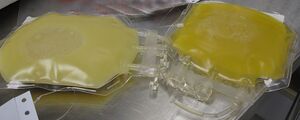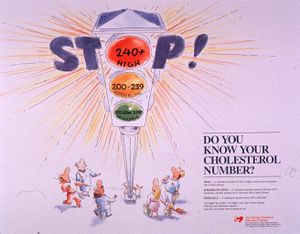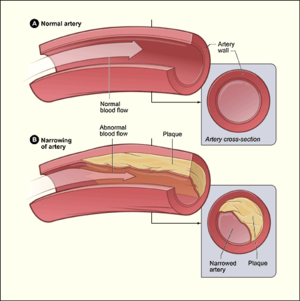Hypercholesterolemia
Original Editor - Lucinda hampton
Top Contributors - Lucinda hampton and Rahma Ahmed Ahmed Bahbah
Introduction[edit | edit source]
Hypercholesterolemia is a specific type of hyperlipidemia[1]. Hypercholesterolemia can be defined as a LDL-cholesterol greater than 190 mg/dL, greater than 160 mg/dL with one major risk factor, or greater than 130 mg/dL with two cardiovascular risk factors.[2]
Hypercholesterolemia
- Can be inherited, but it's often the result of unhealthy lifestyle choices, which make it preventable and treatable. A healthy diet, regular exercise and sometimes medication can help reduce high cholesterol[3].
- Increases the risk of heart disease. Elevated levels of circulating cholesterol cause deposits to form inside blood vessels. These deposits, called plaque, are composed of fats deposited from the bloodstream. When the deposits become sufficiently large, they block blood vessels and decrease the flow of blood. These deposits result in a disease process called atherosclerosis, which can cause blood clots to form that will ultimately stop blood flow.[4]
- Is silent. There are no symptoms that are obvious to the naked eye. It is diagnosed by a blood test or after a heart attack or stroke occurs.[4]
Cholesterol[edit | edit source]
Cholesterol circulates in the blood stream and is an essential molecule for the human body. eg Hormones and steroids are made of cholesterol molecules; Cholesterol molecules maintain neurons.
Between 75 and 80% of the cholesterol that circulates in a person's bloodstream is made in that person's liver with the remainder being acquired from outside sources. Cholesterol is found in animal sources of food, not in plants sources.[4]
Cholesterol Types[edit | edit source]
Cholesterol has been divided into two major categories: low-density lipoprotein (LDL), the so-called "bad" cholesterol, and high-density lipoprotein (HDL), the so-called "good" cholesterol. Diet, exercise, smoking, alcohol, and certain illnesses can affect the levels of both types of cholesterol. Eating a high fat diet will increase one's level of LDL cholesterol. Exercising and reducing one's weight will both increase HDL cholesterol and lower LDL cholesterol[4].
Familial Hypercholesterolemia[edit | edit source]
Familial hypercholesterolemia (FH) is a genetic disorder that affects about 1 in 250 people and increases the likelihood of having coronary heart disease at a younger age.
If you/your client is concerned that they could have familial hypercholesterolemia or hereditary heart disease, the first step is to collect your family health history of heart disease and share this information with your doctor.[5]
Further Information[edit | edit source]
See our great page on Hyperlipidemia and Atherosclerosis
References[edit | edit source]
- ↑ Healthline What’s the Difference Between Hyperlipidemia and Hypercholesterolemia? Available: https://www.healthline.com/health/cholesterol/hyperlipidemia-vs-hypercholesterolemia(accessed 5.3.2022)
- ↑ Ibrahim MA, Asuka E, Jialal I. Hypercholesterolemia. [Updated 2021 Nov 7]. In: StatPearls [Internet]. Treasure Island (FL): StatPearls Publishing; 2022 Jan-. Available from:https://www.ncbi.nlm.nih.gov/books/NBK459188/ (accessed 5.3.2022)
- ↑ Mayo Clinic High cholesterol Available:https://www.mayoclinic.org/diseases-conditions/high-blood-cholesterol/symptoms-causes/syc-20350800 (accessed 5.3.2022)
- ↑ 4.0 4.1 4.2 4.3 The Free Medical Dictionary Hypercholesteremia Available: https://medical-dictionary.thefreedictionary.com/hypercholesterolemia (accessed 5.3.2022)
- ↑ CDC Heart Disease, Family Health History, and Familial Hypercholesterolemia Available:https://www.cdc.gov/genomics/disease/fh/FH.htm (accessed 5.3.2022)









